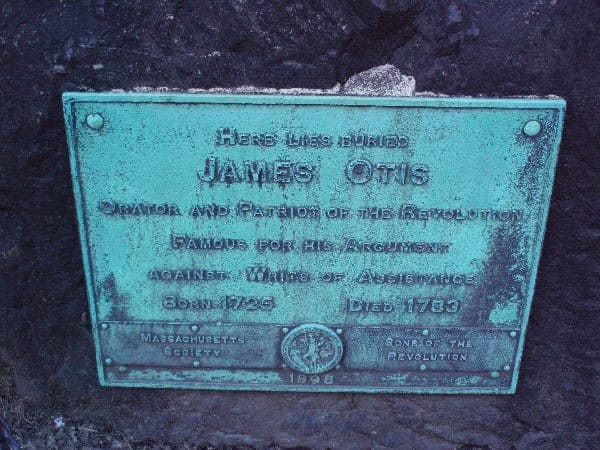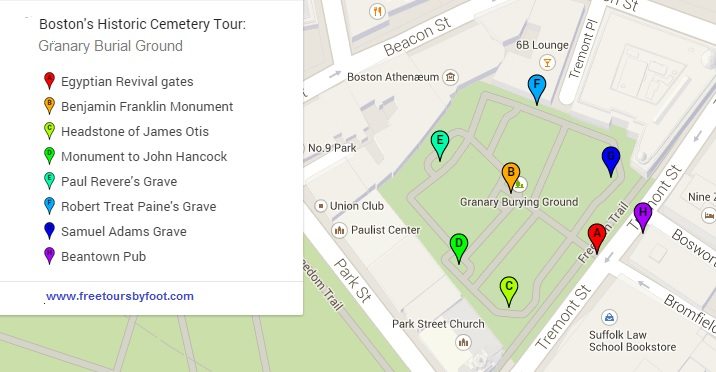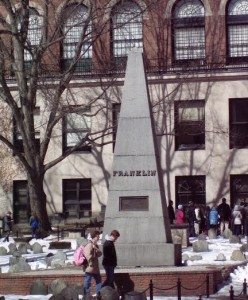This post is about Boston's historic Granary Burying Ground.
We include a short history, who's buried here, how to get here, and a short self-guided tour.
- What Is It?
- How to Get Here
- Self-Guided Tour
- Tourist Discounts
- Things to Do in Boston
- Free Tours by Foot
WHAT IS THE GRANARY BURYING GROUND?
For history buffs and visitors, Boston has several historic cemeteries.
The most centrally located historic cemetery near Boston Common is the Granary Burying Ground, and it is worth exploring.
Boston's Granary Burying Ground is the third oldest burial ground in the City of Boston and within lay the DNA of the American Revolution, including the graves of Paul Revere and Samual Adams.

There are over 5000 bodies buried there, but only an estimated 2300 headstones.
The reason for this is that many of the graves have multiple bodies buried under one headstone, something that was common in most old burial grounds to save money and space.
Among regular citizens who rest inside are three signers of the Declaration of Independence: John Hancock, Samuel Adams, and Robert Treat Pain.
Additionally, one of the least known, but one of the greatest, James Otis, is buried here as well.
The burial ground, which opened in 1660, was named Granary in 1737 for the Old Town Granary which stood on the current site of its neighbor Park Street Church (1809).
It's free to enter the graveyard and it is open to the public for free, every day from 9:00 am to 5:00 pm (17:00).
HOW TO GET HERE
The burial ground is on the Freedom Trail and is tucked between the Park Street Church and Suffolk University, in the heart of central Boston.
Regardless of how you get here, we recommend using this Google Maps link for directions.
If you are arriving by public transportation, take the T to Boston Common and walk northeast on Tremont Street towards the Park St Church.
Past the church, you'll find the cemetery.
If you are unfamiliar with Boston's subway system, then be sure to read our guide on how to use the T.
LET US TAKE YOU HERE
The Granary Burying Ground is a stop on our daily, guided tour of the Freedom Trail.
It is also a stop on our GPS-enabled audio tour of the Freedom Trail, which you could take whenever you like. It's just $2.99/download.
Here's a sample clip below.
If you are considering purchasing a hop-on-hop-off bus ticket while in Boston, then know that all companies stop very near to the cemetery.
Read our post comparing the different bus tours available to you.
WHO IS BURIED IN GRANARY BURYING GROUND?
Here is a quick, self-guided tour to help you find the "big graves" as you meander your way along its paths.
In order to keep the burial ground protected, please make sure you stay on the designated paths.
Learn more about the grounds on our Freedom Trail Tour.
You can also download this tour as a PDF to your smartphone and be sure to take a look at our full selection of self-guided walking tours of Boston.
Click the map to enlarge and click here for a movable map.
Boston’s Historic Cemetery Tour: Granary Burial Ground
(A) - As you enter the Granary Burial Ground on Tremont Street, do you notice the Egyptian Revival gates?
They were designed by Isaiah Rogers who was a supervising architect for the Ohio State House and who also played a role in designing and patenting four burglar-proof vaults built in the northwest corner of the U.S. Treasury Building.
(B) The first and largest monument you will see when entering the Granary is the Franklin Monument.
Don’t be fooled though, Ben is not buried there (his final resting place is at Christ Church Burial Ground in Philadelphia, PA).
Ben was born in Boston but left the city at the age of 17-years-old for a new start in Philadelphia.
(C) Facing the Franklin Monument take a left up the path closest to Tremont Street and follow to the bend where you will see a bolder stone which is the headstone.
This is the headstone of James Otis, a lawyer in Boston and one of the least known, but nevertheless most important American patriots.
James Otis is credited with coining the phrase "Taxation without representation is tyranny!” during a speech in 1761.

He also stated that African Americans had inalienable rights. The idea of racial equality also is talked about in his "Rights of the British Colonies” in 1764.
He was involved in a scuffle in 1769 with Tories that left him with a fractured skull.
Otis suffered from what many believe was bipolar disorder and that the blow to the head contributed to his losing battle with this disease and forced him into retirement after the 1769 attack.
James Otis was struck and killed by lightning in 1783 at the age of 58-years-old. What are the odds of that?

(D) Continuing up the path you will see the monument to John Hancock (you cannot miss it, as it is about as big as the man’s ego).
Hancock, the richest man in Boston at the time and first elected governor of the Commonwealth, also served as President of the Second Continental Congress and was the first person to sign the document The Declaration of Independence in 1776.
His signature is so well known that it inspired an often-used phrase when signing a check or other document which says, "put your John Hancock on that."
John Hancock helped fund the American Revolution with his wealth and was deeply loved by the people in Boston.
John Hancock died in 1793 at the age of 56 years, while serving as Governor.
His name also adorns the tallest building in New England, the John Hancock Tower in Copley Square.
(E) Follow the path to the most famous of all graves in Boston, Paul Revere’s.
You cannot miss it as it is directly behind the Franklin Monument and is in the shape of a pedestal.
Paul Revere was made famous with a poem written in 1860 by Henry Wadsworth Longfellow "The Midnight Ride of Paul Revere", a poem many American primary students have read or memorized in school.
The poem tells the tale of his ride to Lexington and Concord on April 18, 1775, that resulted in the first shot fired in the American Revolution on April 19, 1775.

Paul Revere was a silversmith, a bell maker, and was also appointed the coroner for Suffolk County.
His company sealed the dome of the Massachusetts State House in Copper (it is gilded in gold today).
They also made the bell and bolts for the USS Constitution and lined the keel of the Ship with copper.
Paul Revere died in 1818 at the age of 83.
(F) Continue your loop around the Monument and follow the path to the side brick wall and you will see another signer of the Declaration of Independence: Robert Treat Paine.
Paine is the lesser-known of the Fab Three (Hancock, Adams, Paine) who rest here.
A Harvard Graduate, like both Hancock and Adams, he became the first Attorney General of Massachusetts, and in 1770 he prosecuted the 9 soldiers who were charged with firing on the crowd during the Boston Massacre on March 5, 1770.
He also signed the Olive Branch Petition in 1775, which was the final appeal to King George III for peace in the colonies. Robert Treat Paine died in 1814 at the age of 83.
(G) Continue down the path to the final stop to the late great Samuel Adams.
His headstone looks just like James Otis'.
The bolder headstones are the only two bolder stones in the cemetery and serve almost like bookends in the space.
Many visitors associate Samuel Adams with the beer named for him.
But, while he was for a time a maltster, he has nothing to do with the Sam Adams Brewery in Boston.
Samuel Adams is known as the Mob-master of Boston stirring up much of the discontent in Boston against the Crown and was a founding member of the Sons of Liberty.
He was a charismatic, fiery speaker who whipped up dissent and wrote petitions against the British Crown.
He signed the Declaration of Independence, and at 73 years old, took over the office of Governor after John Hancock died in 1793.
He is the oldest person to serve as Governor in the Commonwealth.
Unlike John Hancock, Samuel Adams spent most of his life in poverty. Samuel Adams died in 1803 at the age of 81.
(H) Now turn and look out through gates across Tremont Street and you will see the Beantown Pub.
As you leave the burial ground you can cross the street, go into the Beantown, and order a Sam Adams beer.
The Beantown Pub is the only place in the world where you can enjoy a cold Sam Adams while sitting across the street from another famous cold Sam Adams.
Why do so many of the grave markers at Granary Burial Ground have a Death Skull?
The skulls are there as a symbol of death and the soul ascending to Heaven.
The earliest stones have skulls, some have skulls and crossbones, and others have skulls with wings.
The stones with skulls with wings symbolize the ascending soul going to heaven after death. The oldest stones have skulls with wings.
As you come along the newer stones (newer meaning the early 1700s onward), they are softened up a little and put skin over the skulls making them look more like angles.
The skulls and skull and crossbones also served as a warning (as many could not read and images were important) for people visiting.
They are saying, "look we are dead, we are all going to face death, get your soul right with God before death comes for you!"
For us today the symbol of the skull and crossbones is a warning to us.
Cheers!
+++To learn more about Boston, come and join our many pay-what-you-like walking tours. The Granary Burial Ground is also part of our pay-what-you-like Freedom Trail tour.+++
RELATED POSTS:










